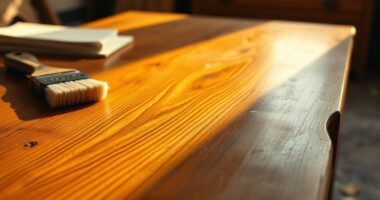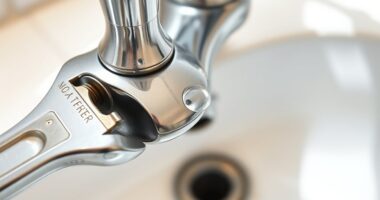To recaulk your tub or shower, start by removing the old caulk carefully with a utility knife and caulk remover. Clean the surface thoroughly with alcohol and let it dry completely. Apply painter’s tape along the edges for neat lines, then load your caulk gun with silicone or acrylic latex caulk. Squeeze a steady bead, smooth it with a finger or tool, remove the tape, and let the caulk cure for 24 hours. Continuing will help you master each step.
Key Takeaways
- Remove old, damaged caulk carefully using a utility knife and caulk remover for a clean surface.
- Clean and dry the area thoroughly before applying new caulk to ensure proper adhesion.
- Use painter’s tape along edges for neat, straight lines during application.
- Load the caulk gun with suitable silicone or latex caulk and apply a steady bead along the joint.
- Smooth the caulk with a tool or finger, remove tape promptly, and allow it to cure fully before use.

Over time, the caulk around your tub or shower can deteriorate, leading to leaks, mold growth, and water damage. When you notice cracks, gaps, or discoloration, it’s a clear sign that it’s time to recaulk. To do this properly, you’ll need the right caulking tools, like a caulk remover, a caulk gun, a utility knife, painter’s tape, and a silicone smoothing tool. These tools help you remove old caulk cleanly and apply new sealant smoothly, preventing common issues like uneven lines, leftover debris, or improper adhesion.
Start by inspecting the existing caulk to identify problem areas. Using a caulk remover or a utility knife, carefully cut away the old caulk without scratching the tub or tile surface. It’s important to remove all remnants because leftover debris can prevent the new caulk from sticking properly, leading to leaks or mold growth later on. Once you’ve scraped away the old caulk, clean the area thoroughly. Use rubbing alcohol or a mild cleaner to remove any soap scum, mold, or oils that could interfere with adhesion. Let the surface dry completely before moving on to the next step.
Before applying the new caulk, apply painter’s tape along the edges of the joint. This creates a clean, straight line and makes cleanup easier. Load your caulk gun with a high-quality silicone or acrylic latex caulk suitable for bathrooms. Cut the tip of the caulk tube at a 45-degree angle, choosing a size that matches the width of the gap. Squeeze the trigger steadily as you run the bead of caulk along the joint. Maintaining consistent pressure helps produce an even line, reducing the need for extensive smoothing later.
Once the caulk is in place, use a silicone smoothing tool or your finger dipped in water to gently shape the bead and press it into the joint. This step ensures proper adhesion and a professional-looking finish. Carefully remove the painter’s tape before the caulk skins over to avoid pulling up the sealant. Allow the caulk to cure according to the manufacturer’s instructions—usually 24 hours—before using the tub or shower. Additionally, understanding the importance of astrological compatibility and how celestial influences can affect confidence may help you approach home improvement projects with a more positive mindset.
Addressing common issues during this process, like uneven application or gaps, requires patience and the right tools. Taking your time to clean thoroughly and apply the caulk carefully will help prevent future problems. Regular inspection and maintenance of your caulk can extend its lifespan, keeping your bathroom watertight and mold-free.
Frequently Asked Questions
How Often Should I Recaulk My Tub or Shower?
You might wonder about the caulking frequency for your tub or shower. Typically, it’s best to recaulk every 1 to 2 years as part of your maintenance schedule. Regular checks help you spot cracks or mold early, preventing water damage. Staying on top of this maintenance guarantees your bathroom stays safe and looking good. Don’t wait too long—prompt recaulkings keep moisture out and protect your space effectively.
What Type of Caulk Is Best for Bathrooms?
When choosing bathroom sealants, you want to pick the right caulk types for durability and water resistance. Silicone caulk is best because it’s flexible, mold-resistant, and handles moisture well. Latex or acrylic caulk can work but may need a sealant additive for bathroom use. Always look for caulk types specifically labeled as bathroom sealants, ensuring they withstand humidity and prevent mold growth.
Can I Recaulk Over Existing Caulk?
You can recaulk over existing caulk, but it may impact caulk longevity and sealing effectiveness. Before doing so, clean the old caulk thoroughly to remove mold and debris. Using proper sealing techniques, like applying a primer or choosing the right type of caulk, helps guarantee a strong bond. Over time, re-caulking improves sealing, prevents water damage, and maintains your bathroom’s appearance. Always assess if removal is necessary for the best results.
How Do I Prevent Mold Growth on New Caulk?
Think of your shower caulk as a protective shield, guarding against hidden invaders like mold. To prevent mold growth, keep the area dry and well-ventilated after each use. Regular caulk maintenance, including cleaning with mold-resistant solutions, helps reinforce this barrier. Remember, a vigilant routine keeps your caulk strong, ensuring it remains a faithful protector and preventing mold from taking hold in the quiet corners.
Is It Necessary to Remove Old Caulk Completely?
Yes, it’s necessary to remove old caulk completely to guarantee a proper seal. You should do caulk removal carefully, scraping away all the old material without damaging the surface. Proper surface preparation is essential; clean and dry the area thoroughly before applying new caulk. Skipping this step can lead to mold growth and poor adhesion. Taking the time for complete removal and preparation helps your new caulk last longer and stay mold-free.
Conclusion
Recaulking your tub or shower is a simple task that can save you money and prevent water damage. Did you know that mold and mildew thrive in just 24-48 hours in damp areas? By regularly resealing, you keep your bathroom healthier and looking great. Just a few minutes of effort can extend the life of your tub and protect your home. So go ahead—recaulk today and enjoy a fresh, leak-free bathroom!









